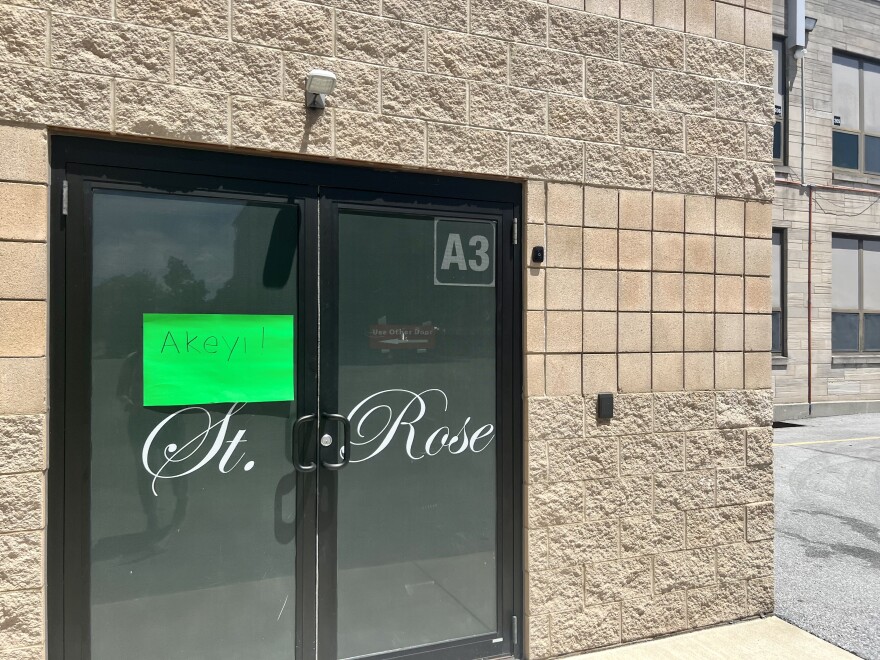Lunch at the St. Rose Community Center begins like every other meal in the community: with a prayer. Except on this summer Sunday, every line is repeated in Haitian Creole.
As the prayer ends, a crowd of new arrivals begins to load their plates with traditional Haitian cuisine. They sit and enjoy rice, beans and fried plantains while speakers approach them and explain how to get a library card, register for English classes and enroll in college.
Julia Joseph fled to Haiti with her family last year to escape the political unrest and violence in Haiti. She wants to become a nurse and help young people.
“I want to buy a house in Lima and live in Lima,” said Joseph.

Kendall Crawford
/
Ohio Newsroom
She is one of many Haitians hoping to find a home in Ohio. Thousands have fled worsening conditions of violence, poverty and food shortages. They have settled across the state in Lima, Findlay and Springfield in search of work.
But in these smaller Ohio communities, a lack of immigration services leaves local nonprofits and churches, like St. Rose, to handle the influx of new Americans.
A sudden increase
Ohio’s abundance of manufacturing jobs and relatively low cost of living have attracted more than just Joseph and her family; an estimated 2,000 Haitians have come to Lima in the last year.
That’s a big jump for a town of 35,000, says Beth Keehn of the local Mercy Health hospital. She noticed the increase last fall, when more patients asked for Haitian Creole interpreters.
““It was pretty clear that something was changing in Lima, Ohio,” Keehn said.

Kendall Crawford
/
Ohio Newsroom
Young families are coming to a community whose population has barely grown in decades. And Haitians need more than just translators, Keehn says. Finding housing, navigating the transportation system and applying for work permits are all challenges for the newcomers. But, Keehn says, Lima doesn’t have a resettlement agency office like larger cities in Ohio.
“(Big cities) have an established kind of resource where you can ask people who are having problems to contact that agency and they will explain the process to them,” Keehn said. “That doesn’t exist here.”
So she jumped into action and helped form a coalition of churches and nonprofits to meet that need. She said they want to connect Haitians with the resources they need to start their lives in Lima.
Community backlash
And while Keehn said local service agencies would be happy to help the new community get built, Lima Councilman Derry Glenn said some in the wider community are afraid.
“There are a lot of lies out there,” said Glenn, a representative of the city’s 6th District.
Glenn heard many false rumors about rising crime rates and the number of immigrants on food stamps. In response, he hosted a forum to debunk some of these myths and address the concerns of community members, such as John Carl, a Lima resident who fears that the small town will not have the infrastructure it needs as its population continues to grow.
“We are doing our best.”
Derry Glenn, Lima City Councillor
““I know Lima is not at capacity right now in terms of people, food supply, electricity and water supply. But look at how quickly the situation has spiraled out of control in all the other states,” Carl said.
Glenn is aware of this fear, but says the city currently has enough resources for the immigrants who have moved there.
“We’re doing the right thing for everyone in our city,” Glenn said. “That’s all we can do.”
A community in transition
Controversial discussions are also taking place in other Ohio cities. Findlay recently formed an immigration task force to address the challenges posed by increasing immigration. In Springfield, city officials are demanding federal aid to cover the rapid population growth caused by immigration.
Keehn said that while many of the community members’ concerns about resources may be valid, Haitians are already part of the Lima community and need to be taken care of like any other neighbor.
“Since there is no perfect answer, we choose humanity,” Keehn said.

Kendall Crawford
/
Ohio Newsroom
This is, they hope, the purpose of the monthly lunches.
At the end of today’s meal, a young Haitian man stands in the middle of the room, strumming his guitar and inviting those present to sing with him. The songs alternate between English and Haitian Creole.
Regardless of the language in which they are sung, each hymn is met with applause. Keehn hopes the wider community can come together in the same way.

